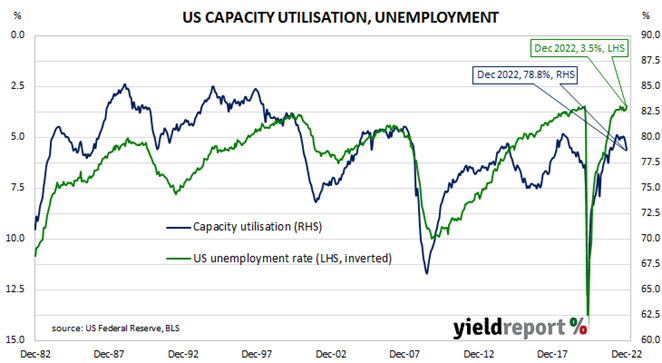Summary: US industrial output down 0.7% in December, below expectations; up 1.6% over past 12 months; pushes back on soft landing narrative; capacity utilisation rate down 0.6ppts to 78.8%, below long-term average.
The Federal Reserve’s industrial production (IP) index measures real output from manufacturing, mining, electricity and gas company facilities located in the United States. These sectors are thought to be sensitive to consumer demand and so some leading indicators of GDP use industrial production figures as a component. US production collapsed through March and April of 2020 before recovering the ground lost over the fifteen months to July 2021.
According to the Federal Reserve, US industrial production contracted by 0.7% on a seasonally adjusted basis in December. The fall was a greater one than the 0.1% decrease which had been generally expected as well as November’s -0.6% after it was revised down from -0.2%. On an annual basis the growth rate slowed from November’s revised figure of 2.2% to 1.6%.
“The decline in retail spending and industrial production adds to the theme of the economy slowing and heading into recession in 2023,” said NAB senior economist Tapas Strickland. It “pushes back on the soft landing narrative dominating markets since January,” he added.
The figures came out the same morning as the latest PPI report and retail sales figures. US Treasury bond yields fell noticeably on the day and, by the close of business, the 2-year Treasury yield had lost 12bps to 4.09%, the 10-year yield had shed 18bps to 3.37% while the 30-year yield finished 12bps lower at 3.54%.
In terms of US Fed policy, expectations of higher federal funds rates over the next 12 months softened. At the close of business, contracts implied the effective federal funds rate would average 4.59% in February, 26bps higher than the current spot rate, and then climb to an average of 4.655% in March. May futures contracts implied a 4.855% average effective federal funds rate while December contracts implied 4.425%.
The same report includes US capacity utilisation figures which are generally accepted as an indicator of future investment expenditure and/or inflationary pressures. Capacity usage had hit a high for the last business cycle in early 2019 before it began a downtrend which ended with April 2020’s multi-decade low of 64.2%. December’s reading fell from November’s revised figure of 79.4% to 78.8%, below the long-term average of 80.0%.
While the US utilisation rate’s correlation with the US jobless rate is solid, it is not as high as the comparable correlation in Australia.



